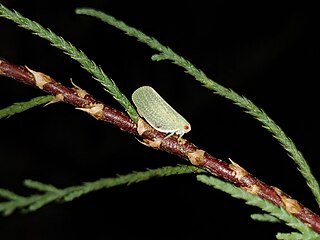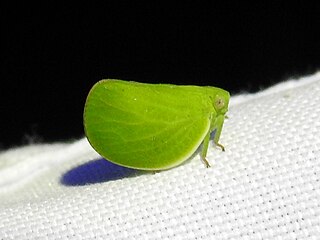
A planthopper is any insect in the infraorder Fulgoromorpha, in the suborder Auchenorrhyncha, a group exceeding 12,500 described species worldwide. The name comes from their remarkable resemblance to leaves and other plants of their environment and that they often "hop" for quick transportation in a similar way to that of grasshoppers. However, planthoppers generally walk very slowly. Distributed worldwide, all members of this group are plant-feeders, though few are considered pests. The infraorder contains only a single superfamily, Fulgoroidea. Fulgoroids are most reliably distinguished from the other Auchenorrhyncha by two features; the bifurcate (Y-shaped) anal vein in the forewing, and the thickened, three-segmented antennae, with a generally round or egg-shaped second segment (pedicel) that bears a fine filamentous arista.

Delphacidae is a family of planthoppers containing about 2000 species, distributed worldwide. Delphacids are separated from other "hoppers" by the prominent spur on the tibia of the hindleg.

Acanalonia is a genus of planthopper and contains the majority of the species within the family Acanaloniidae. They are generally ~1 cm or less in length and are mostly green in color, though some species have pink or tan forms. Like the rest of the Acanaloniidae family, the nymphs and adults feed mostly on the above-ground portions of woody and semi-woody plants and species have one generation per year.

Nogodinidae is a family of planthoppers. They have membranous wings with delicate venation and can be confused with members of other Fulgoroid families such as the Issidae and Tropiduchidae. Some authors treat it as a subfamily of the Issidae. Some of their key features are a frons ("face") that is longer than wide and a reticulate wing venation. They are less than 2 cm long. The antenna arises well below the eye, has the base clubbed and flagellum unsegmented. The lateral ocelli are outside the margins of the face. The face has carinae on the edge. On the hind leg, the second tarsal segment has an apical spine arising from it. The tibia of the hind leg also has spines towards the tip. An important family character is found in the shape of the male genital structure, a style that is longer than broad. Most members of this family are forest species.

Achilidae is a family of planthoppers, sometimes called "achilids" in the order Hemiptera. There are at least 520 described species in Achilidae.

Lycorma imperialis is a planthopper indigenous to parts of China and Indo-Malaysia. L. imperialis was originally discovered in 1846 by Adam White and has one recognized non-nominate subspecies, L. i. punicea. L. imperialis has undergone a number of reclassifications since its discovery and is one of four species in the genus Lycorma. L. imperialis follows a hemimetabolous life cycle and will undergo a series of nymphal stages (instars) before maturing to an adult.

Fowlerium productum is a species of planthopper in the family Issidae. They are native to the Southwestern United States.

Picumna is a genus of planthopper in the family Issidae. They can be found in the Southwestern United States and Central America. Picumna species are often confused with Thionia species, but can be differentiated as Picumna have four spines on their hind tibia, whereas Thionia have fewer.

Picumna chinai is a species of planthopper in the family Issidae. They can be found across the Southwestern United States and Central America.

Abolloptera is a genus of planthoppers with only one species, Abolloptera bistriata. It is found in Texas and north-eastern Mexico.

Acanalonia servillei is a species of planthopper in the family Acanaloniidae. It is a widely distributed species, being found along the East Coast and Gulf Coast of the United States as far southwest as Texas and as far north as New York. It is also found on many Caribbean islands such as The Bahamas, Cuba, Hispaniola, and Jamacia. Like most planthoppers, it feeds on the sap of plants. It is noted as being associated with Capparis cynophallophora along with other plants in the caper family, though not exclusively. It is a quite large species for its family, usually measuring more than 9mm.

Acanalonia chloris is a species of planthopper in the family Acanaloniidae. It can be found in northern Argentina, Chile, and Uruguay.

Acanalonia fasciata is a species of planthopper in the family Acanaloniidae. It can be found in the Southwestern United States and northwestern Mexico. Possible predators include several local species of dryinid wasp. It is a smaller species with a length varying from 4.2 to 6.2 mm. It is often confused with Acanalonia bivittata, but can be differentiated by its smaller size, lack of reticulation on the base of its elytra, and by its range being farther west.

Acanalonia clypeata is a species of planthopper in the family Acanaloniidae. It can be found in the Southwestern United States. It can be found feeding on many plants including but not limited to tumbleweed, four-wing saltbush, baccharises, and Prosopis. It is approximately 7 mm long and 3 mm wide.

Acanalonia immaculata is a species of planthopper in the family Acanaloniidae. It can be found in southern New Mexico and Mexico. It is predated by dryinid wasps such as Apterodryinus torvus.A. immaculata can grow to 6.3 to 7.2 mm long.

Acanalonia virescens is a species of planthopper in the family Acanaloniidae. It is found in coastal regions such as southern coastal Texas, the east cost of Mexico, and as far south as Panama. It was initially recorded in Florida, but has not been found there since.

Acanalonia excavata is a species of planthopper in the family Acanaloniidae. It is native to Nicaragua and is adventive in Florida. It is about 9 mm long.

Acanalonia invenusta is a species of planthopper in the family Acanaloniidae. It is found in New Mexico, Texas, and northern Mexico. It is quite visually similar to Acanalonia similis, though the two can be differentiated by A. invenusta having less prominent reticulation across its elytra. It measures 4.2 - 5.6 mm.

Acanalonia similis is a species of planthopper in the family Acanaloniidae. It is found in Texas, New Mexico, and Arizona. It is quite visually similar to Acanalonia invenusta, but though the two can be differentiated as A. similis has more prominent reticulation across its elytra than A. invenusta. A. similis measures 4.2 - 4.9 mm long.
Batusa is a genus of planthoppers belonging to the family Acanaloniidae. They are found in Mexico, Puerto Rico, and Brazil.


















